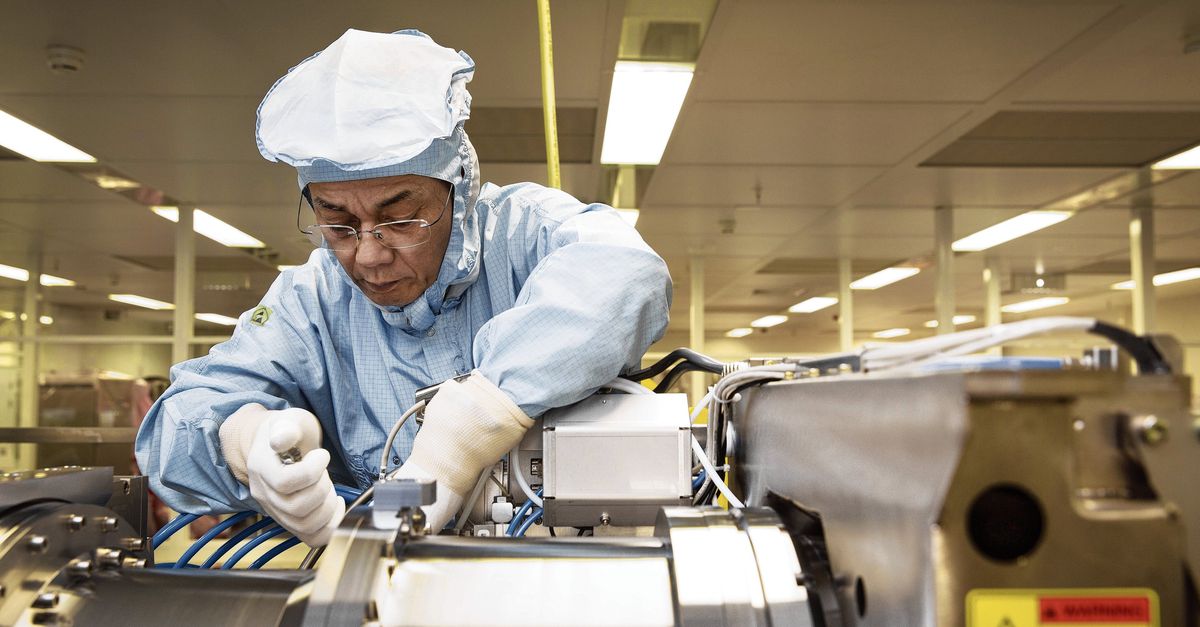How to keep the Chinese at 14 nanometers?
That is, in one sentence, the role of the US diplomatic offensive to slow the growth of the Chinese chip industry. China is years behind in chip technology because manufacturers do not have access to ASML’s more advanced lithography machines. America needs to tighten the handbrake even more.
You can’t see any difference with the naked eye, but the difference between 14 nanometers and 3 nanometers (one millionth of a millimeter) in the chip field is huge. That’s the difference between the more advanced chips that China is currently making and the high-speed chips that companies like Samsung and DSMC are making (thanks to ASML machines).
The closer a chip’s circuits can be placed, the more computing power it can fit per square centimeter. Americans want to keep that advantage to the Western world.
Bloomberg News reported earlier this week that it was talking to Dutch ambassadors about export restrictions for ASML. According to Bloomberg, those talks began after a visit by Don Graves, Secretary of State for the US Department of Commerce. He visited the ASML headquarters in May.
Ultraviolet
In fact, talks between Washington and The Hague have been ongoing for more than a year. This has been confirmed by insiders in Washington and The Hague NRC† The Biden administration appeared to be taking a different tack from the Trump administration’s export restrictions. It doesn’t even go down well with American companies that manufacture chips in China or sell them to China.
The war between Russia and Ukraine has further strained relations between world powers. The Americans are trying to get the Dutch and Japanese governments to limit the export of lithography machines to China. Lithography – the exposure process – is the heart of chip manufacturing. The current technique, with a light source producing ‘deep ultraviolet’ or ‘DUV light’, is more complex than the latest method: ‘extreme ultraviolet’ or ‘EUV’. This is a technique that only ASML masters do. ASML dominates the market for all lithography machines. Other suppliers are Canon and Nikon of Japan.
The US is trying to limit exports of lithography machinery to China
There is an official diplomatic channel to regulate the export of specific technology used for military purposes. That is the ‘Wassenar Arrangement’ agreement between 42 countries including Ukraine and Russia.
Also read this article: What is ASML’s secret? NRC A behind-the-scenes look at the Dutch high-tech marvel
ASML’s EUV technique falls under the Wassenaar arrangement. For example, Americans fear that EUV will give China even more room to develop artificial intelligence. In 2019, the Dutch government did not grant an export license for an EUV machine ordered by Chinese chip company SMIC, at the insistence of the United States.
Earlier this year, the US also proposed to retool DUV technology through the Wassenaar Arrangement. This proposal is unlikely to pass as changes must be adopted by consensus. Due to the war between Ukraine and Russia, the Wassenaar arrangement was practically paralyzed.
According to the Americans, Chinese chip production should be reduced. The National Security Council (security advisors to the US President) pressures the US Department of Commerce to enforce stricter export regulations. Such a move would harm American companies.
Built-in handbrake
If the export ban is imposed, it will also affect US suppliers of chip machinery, such as Lam Research and Applied Materials. ASML doesn’t just supply to Chinese companies in China – companies like Intel, SK Hynix and TSMC also have chip factories in China.
America’s hand reaches far: Export restrictions apply to devices with more than 25 percent American technology. This applies to some parts of ASML machines, but not to the entire lithography machine. It is assembled in Veldhoven. In the first quarter of 2022, ASML earned more than 30 percent of its turnover from deliveries to China, compared to 15 percent for the whole of 2021.
ASML can supply China with chip machines that are very limited in terms of software and cannot produce more advanced chips. But such a built-in handbrake is not an option waiting for ASML.
Meanwhile, the U.S. has yet to pursue a comprehensive support program for its own chip industry. There is a bill to invest $52 billion — the CHIPS Act — but it has been awaiting congressional approval for months. So manufacturers like TSMC and Intel are putting their expansion plans in the US on hold.
A version of this article appeared in the newspaper on 8 July 2022







